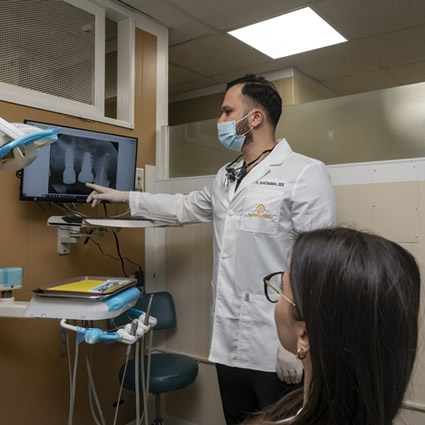Dental X-Rays in Brooklyn
 Performing an X-ray examination of the teeth is essential to allow our dentists to properly diagnose any dental problems and evaluate which options are best to give our patients the results they desire. For many people, this is the first step on the road to recovery.
Performing an X-ray examination of the teeth is essential to allow our dentists to properly diagnose any dental problems and evaluate which options are best to give our patients the results they desire. For many people, this is the first step on the road to recovery.
By studying the images, we can see the interior condition of the bone and any changes that may indicate problems like tooth decay, gum disease, abscesses, or abnormal growths such as a tumor or cyst. In addition, X-rays allow us to determine the location and condition of the affected tooth or any unerupted teeth.
Healthy tissues show as gray on the films, and fillings and implants are characteristically white. A tooth cyst and other neoplasms are displayed as dark areas with a round or oblong shape. Interpreting the films correctly provides a window into what’s going on in the patient’s mouth and what steps we must take to correct any issues.
Advanced Technology for Quality Results
At Aesthetic Dental, we use a new generation of X-ray machines with several advantages—minimal radiation, quick examination, and same-day results, which are essential for timely diagnosis.
We may use several types of X-rays to obtain comprehensive information. These include
- Sighting snapshot—shows the condition of one or more teeth and adjacent tissues to help the specialist assess the condition of dentin, root canals, periodontium, and blood vessels.
- Dental X-ray or orthopantomogram—a detailed flat image of the jaws, teeth, joints, and sinuses. It’s used to detect cavities, defects in fillings, impacted teeth, and cysts and to create a plan for implantation, prosthetics, and treatment.
- Occlusal scan, or X-ray bite—often used in examining children or when it’s impossible to obtain precise results using targeted radiography.
- Computed tomography—the most informative research method. Using 3D visualization technology to display the jaw on the monitor screen allows our dentist to work on the diagnosis and treatment of the patient immediately while keeping a digital record.
These imaging methods help our doctors to identify pathological processes by informing them about the area’s inflammatory process, atrophy, neoplasm, and initial signs of cavities.
Schedule an Appointment
Regular X-rays are essential for good oral health habits and should be included in your yearly check-ups. If it’s been a while since you’ve had yours done, make an appointment to get checked today.
CONTACT US

